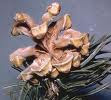Sumac grows wild in many parts of the world and has different botanical names depending on the species. Rhus coriana is native to Sicily, Southern Italy and parts of the Middle East, notably Iran, and can also be found in Greece. It has been cultivated for centuries for its bitter astringent taste and has been employed in the tanning industry.
The name sumac comes from the Aramaic word “summaq” meaning dark red, the colour of the crushed berries. In Greek it is called summaki, and is added to hummus. The colour of crushed sumac is rather similar to that of saffron, and should not be confused with it.
Sumac berries grow in clusters on bushes and can be used fresh or dried. They are used extensively in Arabic cuisine instead of lemon juice and can often be found in shakers to be sprinkled on yoghurt for kebabs and to flavour rice. It can also be used in salads or cooked with meat in sauces, as Dioscorides recommended in the 1st century AD. He used it as medicine to treat bowel problems and as a diuretic. In 1597 Gerard the herbalist wrote of it; - “The seed of Sumach eaten in sauces with meat, stoppeth all manner of fluxes in the belly…” and it is still used in traditional medicine to cure such problems, including flatulence.
 There are several sumacs which are native to North America including poison ivy, Rhus toxicodendron which should be avoided as it causes a painful skin rash. Others are Staghorn sumac, Rhus typhina and Rhus aromatica. Native Americans used the berries, dried as food for the winter months and also used the leaves, bark, milky sap and roots in medicine. Not only does it act as a diuretic, but it has antibacterial properties so is good for getting rid of yeast infections such as candida (thrush). It can also help to dry out the sinuses if you have a cold, and improve the circulation of the blood as it has antioxidant properties. This means that it can protect from cardiovascular diseases.
There are several sumacs which are native to North America including poison ivy, Rhus toxicodendron which should be avoided as it causes a painful skin rash. Others are Staghorn sumac, Rhus typhina and Rhus aromatica. Native Americans used the berries, dried as food for the winter months and also used the leaves, bark, milky sap and roots in medicine. Not only does it act as a diuretic, but it has antibacterial properties so is good for getting rid of yeast infections such as candida (thrush). It can also help to dry out the sinuses if you have a cold, and improve the circulation of the blood as it has antioxidant properties. This means that it can protect from cardiovascular diseases. In ancient Rome and in Italy today, the berries are boiled in water, drained and then pressed to extract the essential oils. These are then mixed with oil or vinegar and stored to be used over salads.
In traditional medicine sumac has been used to cure nervous tension, tension headaches, and mental fatigue.
You can find sumac and thyme in labni, a cheese made in the Middle East from yoghurt.
A word of warning: - if you are allergic to mangoes, cashews, or pistachios avoid eating sumac. If you are not sure test it by putting a little of the drink below onto your skin. If a rash doesn’t develop within 15 minutes, you should have no problems.
Ingredients
10 clusters of sumac berries
1 pint of boiling water
honey to taste
Method
Pour the boiling water over the berries and let them stand for 15 minutes. Squeeze the berries to extract all the juice and strain. Sweeten with honey to taste.
For a drink containing less tannin, soak the berries in cold water overnight.
This is good for stomach complaints.
This has Taste and is a Treat.
























